
La Schiavona, also known as Portrait of a Lady, is a 1510–1512 portrait by Titian of an unknown woman.
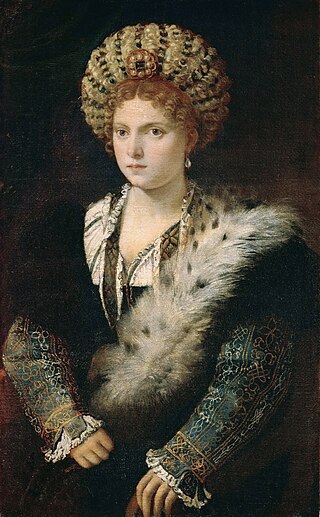
Portrait of Isabella d'Este is an oil on canvas painting of a young woman by Titian. It can be dated to the 1530s and is held in the Kunsthistorisches Museum, in Vienna. The artist and the date are undisputed. Beyond the museum documentation, there are several doubts about the person depicted.
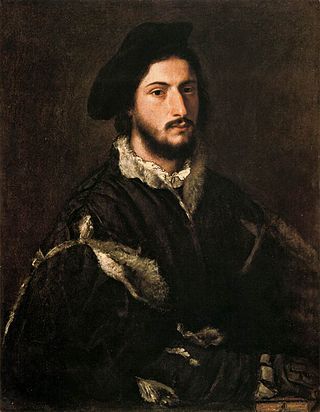
Portrait of Vincenzo Mosti is a painting by Titian, executed around 1520. It is housed in the Galleria Palatina, in Florence.

Lucretia and her Husband Lucius Tarquinius Collatinus or Tarquin and Lucretia is an oil painting attributed to Titian, dated to around 1515 and now in the Kunsthistorisches Museum in Vienna. The attribution to this artist is traditional but uncertain - the brightened palette suggests it could instead be by Palma Vecchio. However, others identify the painting as part of Titian's series of half-length female figures from 1514 to 1515, which also includes the Flora at the Uffizi, the Woman with a Mirror at the Louvre, the Violante and the Young woman in a black dress in Vienna, Vanity in Munich and the Salome at the Galleria Doria Pamphilj. There is an early copy in the Royal Collection.

Flora is an oil painting by Italian late Renaissance painter Titian, dated to around 1515 and now held at the Uffizi Gallery in Florence.

Vanity is an oil painting by the Italian late Renaissance painter Titian, dated to around 1515 and now held at the Alte Pinakothek in Munich, Germany.
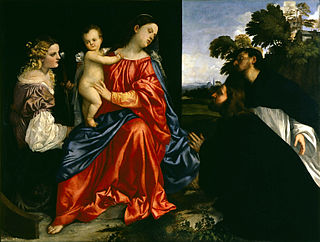
Balbi Holy Conversation is an oil painting by the Italian late Renaissance painter Titian, dated to around 1513, and now held at the Fondazione Magnani-Rocca in Traversetolo, near Parma, northern Italy.

Woman with a Mirror is an oil on canvas painting by Titian, dated to c. 1515. It is held in the Musée du Louvre, in Paris.

The Young Woman in a Black Dress is an oil painting by Titian, dating to c. 1520. It is held at the Kunsthistorisches Museum, in Vienna. It was later misattributed to Palma il Vecchio, then to Giovanni Cariani, until Roberto Longhi reattributed it as by Titian, which is now the critical consensus.

Portrait of Federico II Gonzaga is a painting by Titian, who signed it Ticianus f.. Today in the Museo del Prado, Madrid, it portrays Federico II, Duke of Mantua who married in 1529; the portrait may have been commissioned for the occasion. The dog, a Maltese, is a symbol of faithfulness.

Portrait of a Man is an oil on canvas painting by Titian, dating to c. 1512. Wilhelm von Bode attributed it to Giorgione and Richter to Palma il Vecchio, but Longhi, Suida, Phillips, Morassi, Pallucchini and Pignatti all attributed it to Titian.

The Madonna of the Cherries is a 1515 painting by Titian, heavily influenced by the work of Giovanni Bellini. Originally oil on wood, it was later transferred to canvas. During the 17th century it formed part of the collection of Archduke Leopold Wilhelm, where it was copied by David Teniers. It is now in the Kunsthistorisches Museum in Vienna.
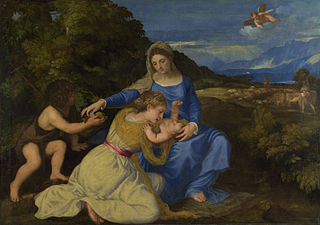
The Aldobrandini Madonna is an oil painting on canvas by Titian, dating to around 1530 and now in the National Gallery, London. There are studio copies in the Galleria Palatina in Florence and in the Kunsthistorisches Museum in Vienna.
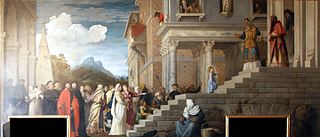
The Presentation of the Virgin at the Temple is a 1534–1538 painting by Titian. It depicts the three year-old Virgin Mary entering the Temple of Jerusalem. It was commissioned by the fraternity based in the Scuola Grande di Santa Maria della Carita, a building later incorporated into the Galleria dell'Accademia, where the work now hangs.
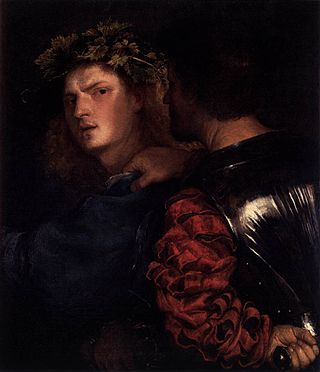
The Bravo is an oil painting usually attributed to Titian, dated to around 1516-17 and now in the Kunsthistorisches Museum in Vienna. The painting can be seen as one of a number of Venetian paintings of the 1510s showing two or three half-length figures with heads close together, often with their expressions and interactions enigmatic. Most of these are "Giorgionesque" genre or tronie subjects where the subjects are anonymous, though the group includes Titian's The Tribute Money, with Christ as the main figure, which in terms of style is similar to this painting, and his Lucretia and her Husband, also in Vienna, where at least the woman's identity is clear, if not that of the man.

Holy Family with a Shepherd is a c. 1510 painting by Titian, now in the National Gallery, London. It has also previously been attributed to Antony van DycK, who produced a drawing copying it. After passing through other private collections, it was bequeathe to the National Gallery by William Holwell Carr in 1831.
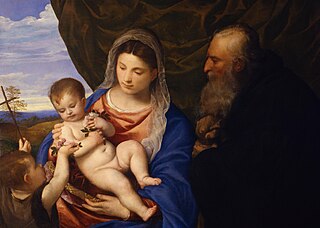
Madonna of the Roses is a c.1530 oil on panel painting by Titian, now in the Uffizi in Florence. As well as the Madonna and Child it also shows Anthony the Great. and a young John the Baptist. It is signed "Ticianus f.", but this may be a later addition.

Portrait of a Man is an oil painting by Titian, made about 1515, now in the Indianapolis Museum of Art.

Isabella in Red is a portrait of a woman by Peter Paul Rubens in the Kunsthistorisches Museum in Vienna. It is considered a close copy of a lost Titian original.

Portrait of Ranuccio Farnese is an oil on canvas painting of Ranuccio Farnese by Titian, from c. 1542. It is held in the National Gallery of Art, in Washington, D.C.. One of the first portraits of a Farnese by the artist, it is signed "Titianvs F.".

























